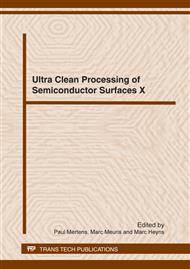p.181
p.185
p.193
p.197
p.201
p.207
p.211
p.215
p.219
Optimized Wetting Behavior of Water-Based Cleaning Solutions for Plasma Etch Residue Removal by Application of Surfactants
Abstract:
Wet chemical plasma etch residue removal is a promising alternative to low-k dielectric degrading plasma cleaning processes. With decreasing feature dimensions the wetting behavior of the liquid on low energetic surfaces present after dielectric patterning will be an important issue in developing wet cleaning solutions. High surface energy liquids may not only be unable to wet low energetic surfaces, but can also cause nonwetting of small structures or pattern collapse. The improvement of the wetting behavior of a cleaning liquid by lowering its surface energy by the addition of surfactants is the strategy followed in this study. We show that with choosing the appropriate rinsing solution a wet chemical process using surfactant aided cleaning solutions compatible to the materials used in BEOL (porous low-k, copper, barriers) can be found. The results show a distinct improvement of the wetting behavior of the modified solutions on several low energetic solid surfaces like copper or polymers deposited during dry etching.
Info:
Periodical:
Pages:
201-205
Citation:
Online since:
April 2012
Authors:
Keywords:
Price:
Сopyright:
© 2012 Trans Tech Publications Ltd. All Rights Reserved
Share:
Citation:


